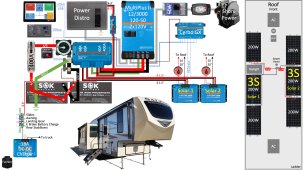mkrieger
New Member
- Joined
- Apr 11, 2022
- Messages
- 4
Hi all! I've gone back and forth looking for the perfect solution, but can't seem to land on one particular thing.
Here's what I'd like to do. I have a camper that has 2 50Ah AGM batteries in it now. It's currently set up for solar, AC, and tow vehicle charging. Right now, the charger system is the Noco Genius Gen 2 2 bank 20A charger. It's a 12V system.
I want to replace these batteries with new LiFePO4 lithium batteries (or just one battery) for a total of 200Ah. I want to be able to have the batteries be self-heating (live in a cold climate), have under/over temp charge protection, and be able to charge with solar, 120v AC, and/or my tow vehicle.
So what would everyone suggest in the way of components? Are there schematics showing how to hook things up that you can point me to? I can't seem to find the 'whole picture' anywhere.
Any guidance would be greatly appreciated!
Here's what I'd like to do. I have a camper that has 2 50Ah AGM batteries in it now. It's currently set up for solar, AC, and tow vehicle charging. Right now, the charger system is the Noco Genius Gen 2 2 bank 20A charger. It's a 12V system.
I want to replace these batteries with new LiFePO4 lithium batteries (or just one battery) for a total of 200Ah. I want to be able to have the batteries be self-heating (live in a cold climate), have under/over temp charge protection, and be able to charge with solar, 120v AC, and/or my tow vehicle.
So what would everyone suggest in the way of components? Are there schematics showing how to hook things up that you can point me to? I can't seem to find the 'whole picture' anywhere.
Any guidance would be greatly appreciated!



